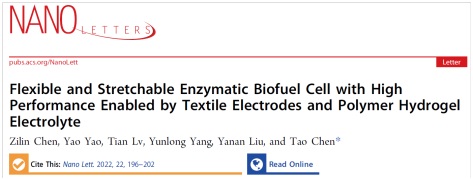Professor Chen Tao's research team of our school has made important progress in flexible biofuel cells recently and released their outcomes by publishing a paper titled Flexible and Stretchable Enzymatic Biofuel Cell with High Performance Enabled by Textile Electrodes and Polymer Hydrogel Electrolyte inNano Letters, an important international academic journal on nano materials.

As flexible wearable electronics have attracted much attention due to their potential application value in the fields of portable display, online sensing, human health management, etc., the development of energy conversion or storage deviceswith good compatibility with such electronics is of crucial importance.Biofuel cells (BFC) that convert chemical energy (such as glucose) into electrical energy have broad application prospects, due to high cleanliness and good biocompatibility. Traditional biofuel cells are usually filled with liquid electrolyte, imposing a restriction on the flexibility andstretchability of electrode materials, which poses great challenges to achieving high-performance flexible and stretchable biofuel cells.
Professor Chen Tao's research team has been committed to the research of flexible biofuel cells. The biofuel cells under the current development are assembled by a graphene/carbon nanotube/enzyme composite fabric electrode and polyacrylamide hydrogel electrolyte containing glucose (Figure 1).In the fabric electrode, the carbon nanotube array covalently grown from the graphene layer can not only serve as a conductive substrateand be used to immobilize enzyme molecules, but also enable the enzyme with efficient charge exchange and transfer with the graphene electrode.Therefore, the developed biofuel cells can output at an open-circuit voltage of 0.65 V and a power density of 64.2 μW cm-2.

Figure 1. Schematic Diagram of Graphene/Carbon Nanotube/Enzyme Composite Fabric Bioelectrode and Flexible/Stretchable Biofuel Cell
Thanks to the fabric-like structure of the electrode material and the excellent flexibility and stretchability of the polymer hydrogel electrolyte, the biofuel cells remain almost unchangedin electrochemical properties, subject to bending at any angle (0~180°), even for 400 cycles of bending/release.Under a tensile strain of up to 60%, the biofuel cells remain basically unchanged at the open-circuit voltage, and the power density of 93.5% of the original value, showing excellent flexibility and stretchability (Figure 2).The biofuel cells are in flexibility and stretchability well matched with biological tissue, such as nerve tissue (~20%), blood vessels (~30%) and skin (~50%), and are expected to be applied as an energy supply system in the field of in-vitro/in-vivo bioelectronic equipment in the future.

Figure 2. Flexibility and Stretchability of Enzyme Biofuel Cell
Chen Zilin, a doctoral candidate of our school, contributed as the first author, and Professor Chen Tao as the corresponding author. The research work was funded by the National Natural Science Foundation of China and a program sponsored by Shanghai Municipal Education Commission.